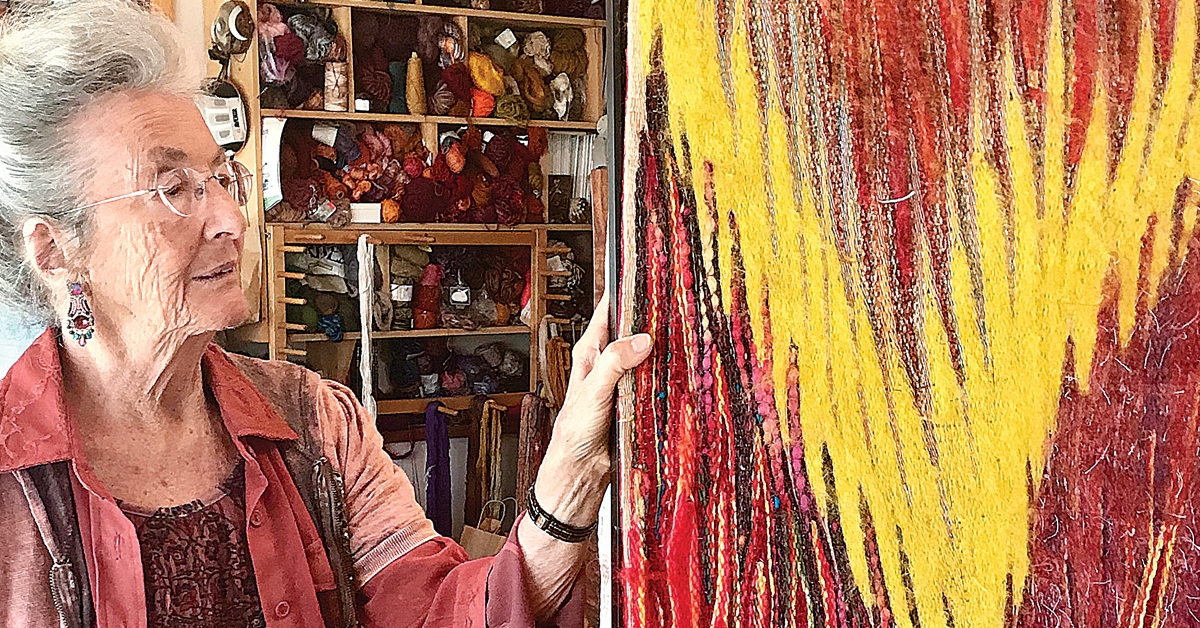by GAIL JOKERST
’Tis a rare woman who can say, “I love spiders, and I love winter,” all in the same breath. But no one acquainted with Joan Renne would be surprised to learn those are her sentiments.
As a master weaver, Renne admires the skill of arachnid artists, whom she regards as, “the original orb weavers.” She has sat all day watching a spider spin a web and will go so far as to take one outside rather than kill it.
Spiders have even inspired one of her most sought-after tapestry designs called “Window Webs.”
A Montanan with a lifelong zeal for the natural world, Renne looks forward to the season’s first snowfall as enthusiastically as kids anticipate Christmas. She skis for hours on end, gliding through snowy woodlands outside her Flathead Lake home as capably as she finger-weaves at one of her five looms.
“Weaving calms me. Life is complicated and extremely nerve wracking. Weaving is a very quiet pursuit. It’s a slow, tedious process, and that’s what I like about it. At 3 inches an hour, it’s not quick, but it’s something I really had to do,” remarked Renne, whose pioneer grandmothers tatted and made intricate bobbin lace to embellish items such as handkerchiefs and slips.
Renne traces her passion for weaving to those grandparents and to her childhood growing up in Bozeman. At that time, her father, Roland, an Agricultural Economics Professor, was president of Montana State University and striving to promote its expansion. Her mother, aside from raising five children, became an early-day proponent of The Wilderness Society. She championed the establishment of the Great Bear Wilderness and instilled in Renne a love for hiking and camping along with the need to protect our last best places.
“My mother taught me everything I know about the outdoors, including the names of the plants, trees, and birds. Her best friend was Harriet Douglas Tidball, who wove reams of yardage for clothing and was one of the finest weavers in the world,” recalled Renne. Tidball taught Renne how to throw a shuttle and encouraged her to attend Tidball’s alma mater, Oberlin College. Renne did attend Oberlin, however, she chose to pursue a degree in music rather than textiles.
Some of her fondest memories of those Bozeman years relate to music as well as to weaving. In particular, she was captivated by the Romani melodies she heard wafting through the open windows of her girlhood home.
“Gypsies had a camp outside the farm where I grew up. They would play violins and guitars in the evening. It was a very early influence on me,” recounted Renne. “I begged my parents for an instrument and started with the piano, but I really wanted to play the violin. They eventually bought me one from Sears, and I taught myself how to play it—badly.”
At Oberlin, Renne’s studies focused on the viola, which she described as, “bigger and deeper than a violin with a mellow, warm, middle-of-the-body sound.” After Oberlin, Renne’s viola playing earned her a full scholarship to attend the New England Conservatory of Music, where her education continued to blossom.
These days, she plays every stringed instrument conceivable, including the more obscure sitar, erhu, and morin khwr, hailing respectively from India, China, and Mongolia. She also plays a host of other instruments, except members of the wind family.
“Music has been my life for a long time,” commented Renne, who has taught voice and various instruments for 28 years.
People hear about her through word-of-mouth endorsement, which has attracted everyone from grade schoolers to great grandpas, to her Kalispell studio.
“I’ve taught tons of students who are all over the world. I’ve had incredible students. It’s wonderful to see someone come into their own with music. Some even write and say how important it was to have me in their life,” said Renne.
“I’m a dyed-in-the-wool native Montanan and have tried to give back to others what I’ve got, which is through music education,” stated Renne, whose favorite composer depends on the day. “I like all the classical composers, and I like what’s happening in the modern music world with its diverse instruments. I listen to everything, including jazz, hip-hop, and rap. I also like opera. That’s an acquired taste.”
As a violist, Renne has performed on stages around the U.S. as well as in Italy, France, Peru, and Chile. Wherever her travels have taken her, stateside or abroad, Renne has bought all kinds of yarn imaginable to use in her weavings.
Her collection is now so extensive she is never concerned about running out of yarn.
When considering her approach to weaving or to music, one thing remains constant—the value Renne places on improvising.
“I’m quite a renegade. I make up my own patterns and do what I want. I like every color. The ones I choose depend on the mood I’m in. I try to use colors that spark my interest and enjoy working with metal because I can sculpt it,” said Renne, who likewise cherishes the freedom that improvisation brings to music.
“Improvisation is spontaneous; it captures how you feel at the moment. There are no wrong notes. Improvisation is where music starts. You aren’t meeting anyone’s standards,” she explained. “It frees you to try new things.”
Although not all of Renne’s students feel comfortable embracing this philosophy, she does her utmost to motivate them to give it a try. As she said, “You have to be strong and feel positive about your playing.”
In thinking about why music matters to her and the world, Renne said, “Music touches your heart, body, soul, and mind. It’s a language. You don’t need words when you make music. It unites everything in your body. You play and listen with everything you have. It moves your entire being. People can communicate with music when they can’t with anything else. It’s sacred in my opinion, every minute of it.”
Whether Renne is better known for her tapestries or for her musicianship is debatable. It is, however, unmistakably her contribution to fiber arts and her family’s deep Montana roots that prompted her inclusion in Helena’s beloved Women’s Commemorative Mural.
Anyone who has walked the length of Last Chance Gulch has undoubtedly seen the 3,000-square-foot mural painted on the south face of Livestock Building. It depicts archetypal women from Montana’s distant and not-so-distant past who have influenced Treasure State history.
Some of the figures were painted from imagination while others portray identifiable individuals. A pioneer and a native American are represented along with suffragettes and even ladies of the night.
You can also find Renne, if you know what she looked like in 1979 when the mural was painted—dark haired with a signature white streak. She is pictured behind a spinning wheel, though she admittedly prefers, “to make colors work as opposed to spinning.”
Looking back at what she deems her greatest accomplishments over her 80 years on planet Earth, Renne’s list surprisingly contains neither tapestries nor music. Instead, she cites her affection for the land, her sense of home, and her family.
“I have three wonderful sons; they are good people, honest and sincere. Holding my mother’s hand while she died was pretty incredible. It was a gift,” she added. “I built my house out of natural wood and 13 tons of stone that I carried from Perma. Just staying here on this land has been an accomplishment.”
And most recently she has every reason to feel proud of another accomplishment—an April hike she took with one of her sons and two granddaughters to the bottom of the Grand Canyon. By anyone’s standards, that’s a strenuous trek.
“We hiked down in a day; I recovered the next two days. Then we hiked back out after a long time of many switchbacks. I loved it, though,” said Renne, who jokingly dubbed her granddaughters “the water police.”
“I was forced to drink two liters of water in the morning and two in the afternoon. And they checked on me to make sure I did. But I had no sore muscles because of all that water.”
One of Renne’s sweetest recollections of the adventure was the reaction her presence on the trail elicited from some of the strapping younger hikers she met, who looked like they belonged on the pages of a Patagonia catalog.
“So many of these beautiful, obviously fit people stopped and told me they admired what I was doing. They even said they hoped to hike this trail when they were my age. When they told me I was their inspiration, that energized me even more,” shared Renne, who believes passionately in living in the moment.
“There is only one thing that’s important. There is just right now, all the time, nowhere else,” she emphasized. “Be in the present always. If you aren’t, you’re in trouble.” MSN









